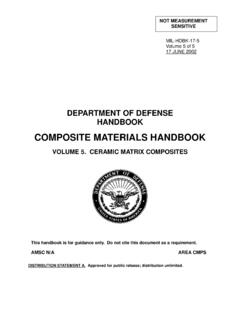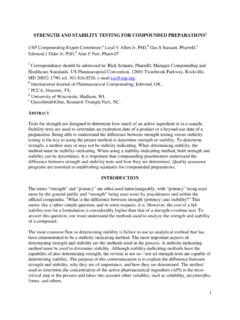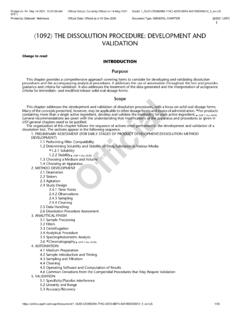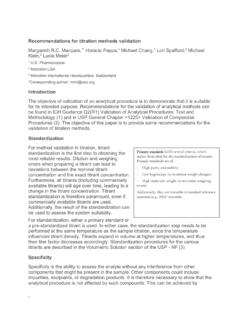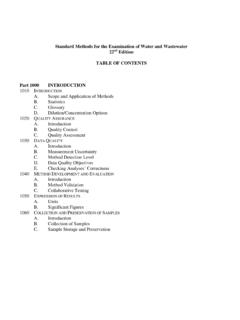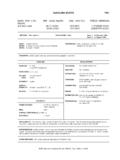Transcription of DEPARTMENT OF DEFENSE HANDBOOK - UC Davis
1 NOT MEASUREMENT SENSITIVE MIL-HDBK-17-1F Volume 1 of 5 17 JUNE 2002 Superseding MIL-HDBK-17-1E 23 JANUARY 1997 DEPARTMENT OF DEFENSE HANDBOOK COMPOSITE MATERIALS HANDBOOK VOLUME 1. POLYMER MATRIX COMPOSITES GUIDELINES FOR CHARACTERIZATION OF STRUCTURAL MATERIALS This HANDBOOK is for guidance only. Do not cite this document as a requirement. AMSC N/A AREA CMPS DISTRIBUTION STATEMENT A. Approved for public release; distribution unlimited.
2 MIL-HDBK-17-1F Volume 1, Foreword / Table of Contents ii FOREWORD 1. This Composite Materials HANDBOOK Series, MIL-HDBK-17, are approved for use by all Departments and Agencies of the DEPARTMENT of DEFENSE . 2. This HANDBOOK is for guidance only. This HANDBOOK cannot be cited as a requirement. If it is, the con-tractor does not have to comply. This mandate is a DoD requirement only; it is not applicable to the Federal Aviation Administration (FAA) or other government agencies. 3. Every effort has been made to reflect the latest information on polymer (organic), metal, and ceramic composites. The HANDBOOK is continually reviewed and revised to ensure its completeness and cur-rentness. Documentation for the secretariat should be directed to: Materials Sciences Corporation, MIL-HDBK-17 Secretariat, 500 Office Center Drive, Suite 250, Fort Washington, PA 19034. 4. MIL-HDBK-17 provides guidelines and material properties for polymer (organic), metal, and ceramic matrix composite materials.
3 The first three volumes of this HANDBOOK currently focus on, but are not limited to, polymeric composites intended for aircraft and aerospace vehicles. Metal matrix compos-ites (MMC) and ceramic matrix composites (CMC), including carbon-carbon composites (C-C) are covered in Volume 4 and Volume 5 , respectively. 5. This standardization HANDBOOK has been developed and is being maintained as a joint effort of the DEPARTMENT of DEFENSE and the Federal Aviation Administration. 6. The information contained in this HANDBOOK was obtained from materials producers, industry, reports on Government sponsored research, the open literature, and by contact with research laboratories and those who participate in the MIL-HDBK-17 coordination activity. 7. All information and data contained in this HANDBOOK have been coordinated with industry and the Army, Navy, Air Force, NASA, and Federal Aviation Administration prior to publication.
4 8. Copies of this document and revisions thereto may be obtained from the Document Automation and Production Service (DAPS), Bldg. 4D, (DODSSP/ASSIST), 700 Robbins Avenue, Philadelphia, PA 19111-5094. 9. Beneficial comments (recommendations, additions, deletions) and any pertinent data which may be of use in improving this document should be addressed to: Army Research Laboratory, Weapons and Materials Research Directorate, Attn: AMSRL-WM-MA, Aberdeen Proving Ground, MD 21005-5069, by using the Standardization Document Improvement Proposal (DD Form 1426) appearing at the end of this document or by letter. MIL-HDBK-17-1F Volume 1, Foreword / Table of Contents iii CONTENTS Page Foreword ..ii Summary of Changes .. xvii CHAPTER 1 OBJECTIVES .. 1 1 1 2 Strength properties and allowables data .. 3 Volume 1: Guidelines for Characterization of Structural Materials .. 3 Volume 2: Material Properties.
5 3 Volume 3: Materials Usage, Design, and Analysis Guidelines .. 4 USE OF THE DOCUMENT AND LIMITATIONS .. 4 Roadmaps for use of Volumes 1 - 3 .. 4 Source of 16 Use of data and guidelines in applications .. 16 Strength properties and allowables 16 Use of references .. 16 Use of tradenames and product names .. 17 Toxicity, health hazards, and safety .. 17 Ozone depleting 17 APPROVAL 17 SYMBOLS, ABBREVIATIONS, AND SYSTEMS OF 18 Symbols and 18 Constituent 23 Laminae and laminates .. 23 Subscripts .. 24 Superscripts .. 25 Acronyms .. 26 System of units .. 27 29 REFERENCES .. 50 CHAPTER 2 GUIDELINES FOR PROPERTY TESTING OF COMPOSITES .. 1 1 Building-block approach to substantiation of composite 1 Test levels and data uses .. 2 Structural complexity levels .. 2 Data application categories .. 3 Test program definition .. 4 TEST PROGRAM PLANNING .. 5 Overview .. 5 Baseline and alternate approaches for statistically-based properties.
6 6 Issues of data equivalence .. 6 Test method selection .. 7 Population sampling and sizing ..11 Sample size selection ..11 Batch quantity effects on ANOVA .. 12 MIL-HDBK-17-1F Volume 1, Foreword / Table of Contents iv Material and processing variation, specimen preparation and NDE .. 13 Materials and material processing .. 13 Specimen preparation and NDE .. 16 Moisture absorption and conditioning factors.. 16 Moisture diffusivity .. 18 Moisture equilibrium 18 Conditioning and test environment .. 20 Material operational limit (MOL).. 20 Steam pressure delamination .. 24 MOL considerations for high temperature composite systems .. 24 Hot Wet Testing - Report Moisture Content at 27 Nonambient testing .. 29 Unidirectional lamina properties from 29 Data normalization .. 29 Data 29 Application specific testing 31 RECOMMENDED TEST 31 Material screening test matrices .. 31 Mechanical property 31 Mechanical property screening for high-temperature material 32 Fluid sensitivity 33 Material qualification test matrices.
7 38 Constituent test matrix .. 38 Prepreg test matrix .. 38 Lamina test 39 Filament-wound materials test 41 Material acceptance test matrices .. 42 Alternate material equivalence test 42 Qualification of alternate source composite 42 42 Goal and 42 Material 43 Key material or structural performance 43 Success criteria .. 43 Lamina-level test matrices for alternate material assessment .. 45 Laminate-level test matrices for alternate material assessment .. 48 Alternate material evaluation 48 Evaluation of changes made to previously qualified 48 Modification 50 Actions required for each modification category .. 51 Implementation .. 51 Validation test matrices .. 56 Generic laminate/structural element test matrices .. 56 Introduction .. 56 Overview .. 58 Laminate strength test matrix .. 58 Bolt bearing and bearing/bypass strength test matrix .. 60 Alternate approaches to basis 64 Lamina mechanical property test matrix for regression analysis.
8 64 Data substantiation for use of basis values from MIL-HDBK-17 or other large databases ..66 DATA REDUCTION AND DOCUMENTATION .. 67 Introduction ..67 Lamina properties from laminates .. 67 Methodology .. 68 Tension strength 69 MIL-HDBK-17-1F Volume 1, Foreword / Table of Contents v Compression strength tests .. 70 Other 70 Data normalization .. 70 Normalization 71 Normalization methodology .. 71 Practical application of normalization .. 74 Dispositioning of Outlier Data .. 75 Data 78 MATERIAL TESTING FOR SUBMISSION OF DATA TO MIL-HDBK-17 .. 78 Introduction ..78 Material and process specification requirements .. 80 Sampling requirements .. 80 Additional requirements for B and A data classes .. 81 Data 81 Conditioning 82 Test method requirements .. 82 Data documentation 82 Data normalization .. 87 Statistical 87 Mechanical properties of laminae and laminates .. 87 Unidirectional properties from laminates.
9 87 Strength and strain-to-failure .. 87 Elastic moduli, Poisson's ratios, and stress/strain curves .. 88 Chemical properties .. 88 Physical properties of laminae and laminates .. 88 Density .. 88 Composition .. 88 Equilibrium moisture content .. 88 Moisture diffusivity .. 88 Coefficient of moisture expansion .. 88 Glass transition temperature .. 88 Thermal 89 Coefficient of thermal expansion .. 89 Specific heat .. 89 Thermal 89 Thermal 89 Electrical properties .. 90 Fatigue 90 REFERENCES .. 92 CHAPTER 3 EVALUATION OF REINFORCEMENT FIBERS .. 1 1 CHEMICAL TECHNIQUES .. 1 Elemental analysis .. 1 Titration .. 2 Fiber 2 Fiber surface chemistry .. 2 Sizing content and composition .. 5 Moisture content .. 5 Thermal stability and oxidative resistance .. 5 Chemical resistance .. 5 PHYSICAL TECHNIQUES (INTRINSIC) .. 6 Filament diameter .. 6 Density of fibers ..6 MIL-HDBK-17-1F Volume 1, Foreword / Table of Contents vi Overview.
10 6 ASTM D 3800, Standard Test Method for Density of High-Modulus Fibers .. 7 Recommended procedure changes to Section (helium pycnometry) for use in measuring fiber 8 Density test methods for MIL-HDBK-17 data submittal .. 8 Electrical resistivity ..8 Coefficient of thermal expansion .. 9 Thermal 9 Specific heat .. 9 Thermal transition 9 PHYSICAL TECHNIQUES (EXTRINSIC) .. 9 Yield of yarn, strand, or roving .. 9 Cross-sectional area of yarn or tow .. 10 Twist of Fabric construction .. 10 Fabric areal density .. 10 MECHANICAL TESTING OF FIBERS .. 10 Tensile 10 Filament tensile testing ..11 Tow tensile testing ..11 Fiber properties from unidirectional laminate 14 Filament compression testing .. 14 TEST METHODS .. 14 Determination of pH .. 14 14 Apparatus .. 14 Procedure .. 15 Determination of amount of sizing on carbon fibers .. 15 15 Apparatus .. 15 Materials .. 16 Procedure .. 16 Calculation.
